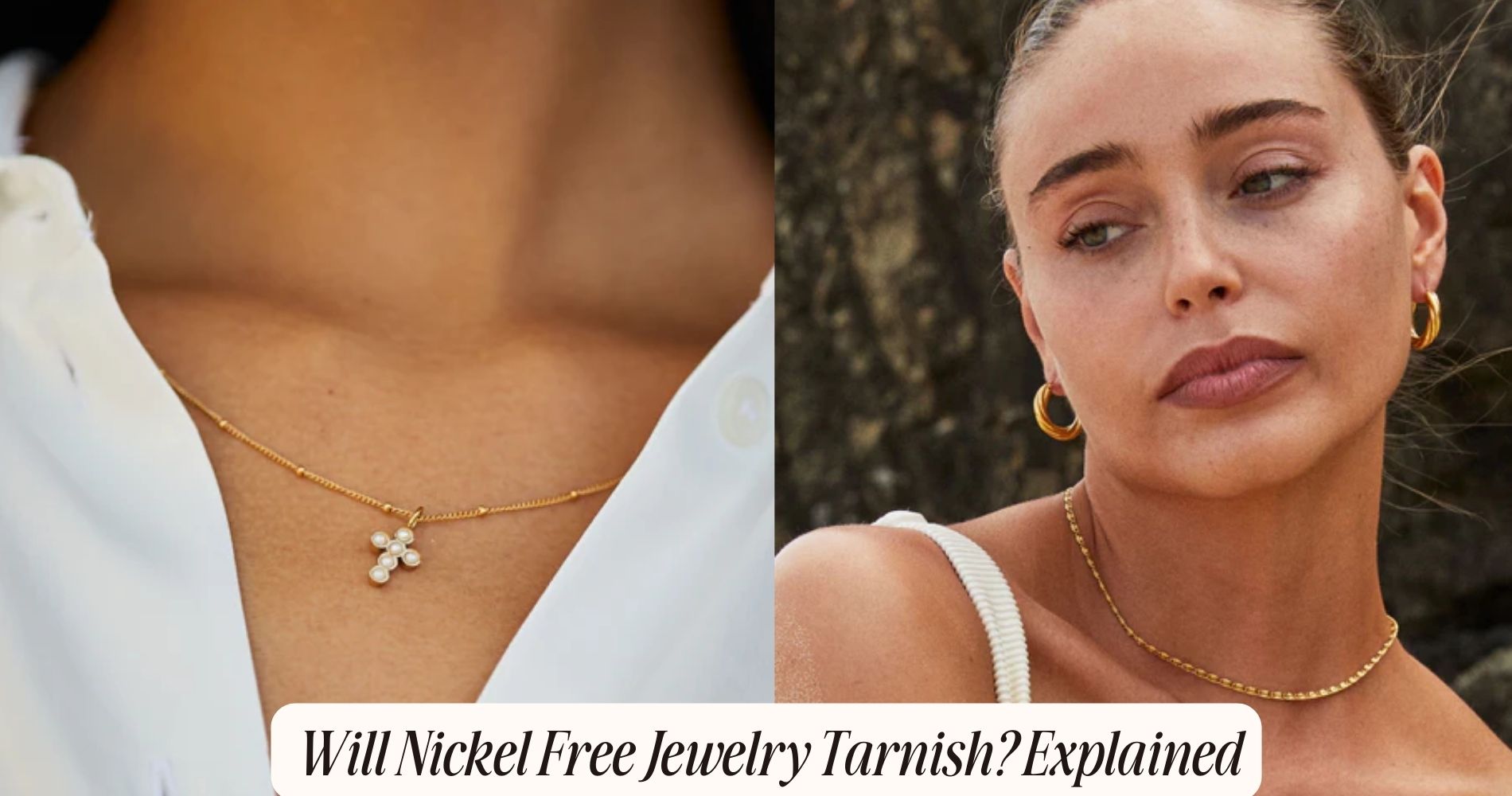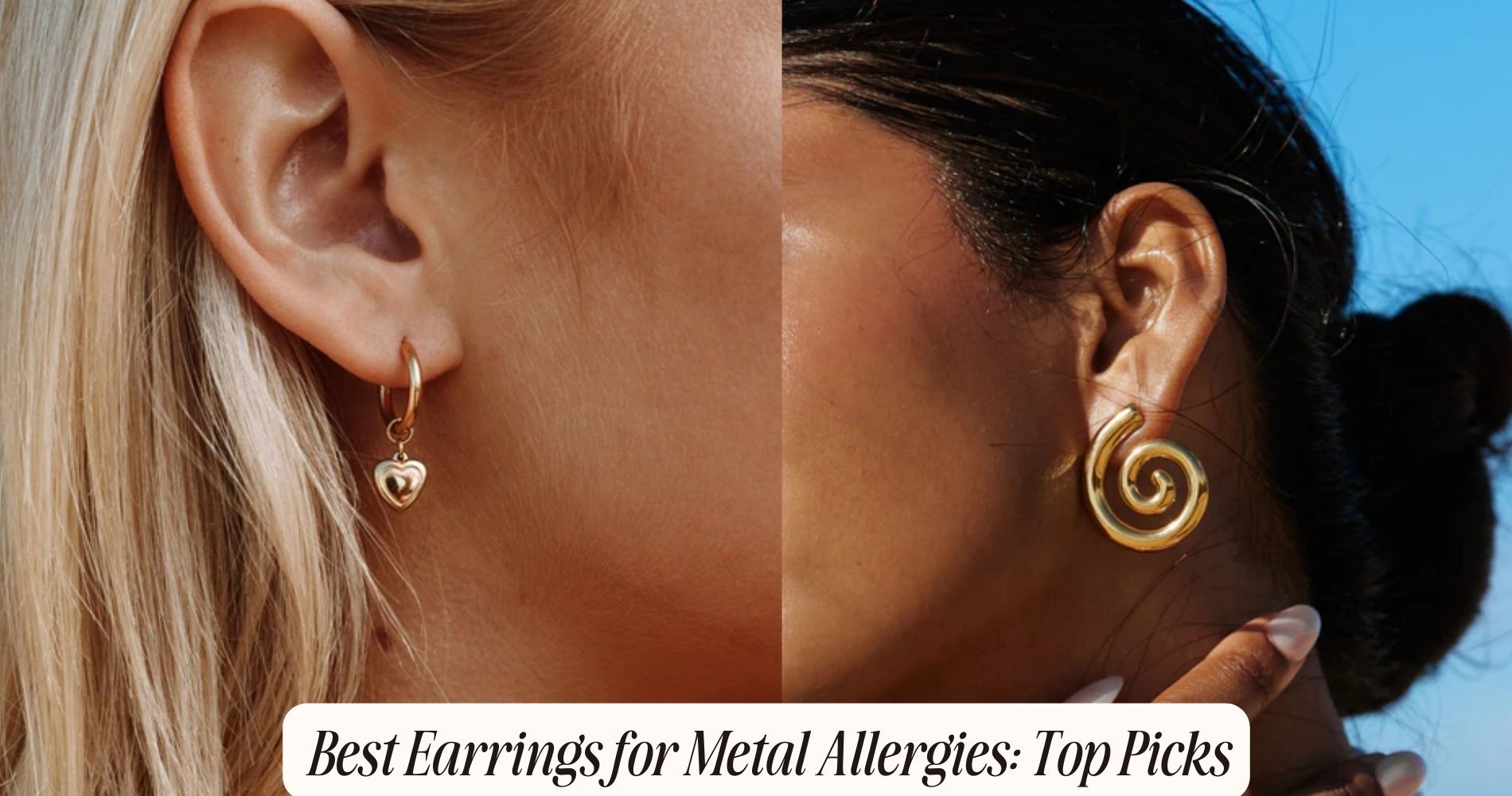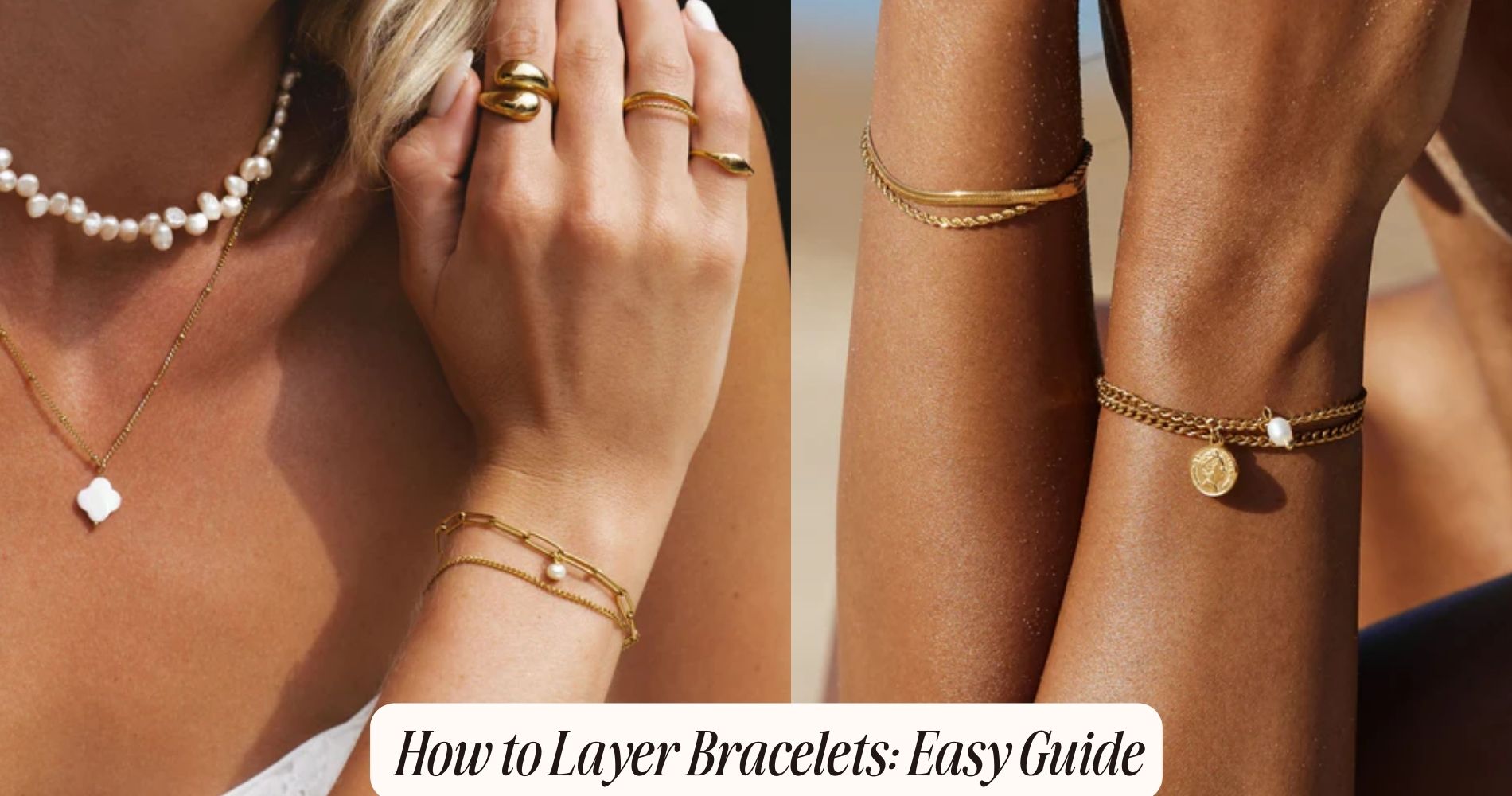
Will Nickel Free Jewelry Tarnish? Explained
Understanding Nickel-Free Jewelry
Understanding nickel-free jewelry involves recognizing the specific materials and manufacturing processes employed to guarantee that no nickel is present, thereby reducing the risk of allergic reactions and tarnishing. When you choose nickel-free jewelry, you're opting for pieces crafted from hypoallergenic materials. These materials are meticulously selected to make sure they don't cause skin irritations or allergic reactions, which nickel frequently triggers.
The most common hypoallergenic materials include titanium, surgical-grade stainless steel, and certain grades of gold and silver.
Manufacturing processes for nickel-free jewelry are stringently controlled. This means that during the production phases, from alloying to finishing, every step is monitored to prevent contamination with nickel. Advanced techniques, such as electroplating with hypoallergenic metals or using physical vapor deposition (PVD), are often employed to create a protective barrier, ensuring the base metal doesn't come into contact with your skin.
Common Metals in Nickel-Free Jewelry
When selecting nickel-free jewelry, you'll often encounter sterling silver and stainless steel as primary options.
Sterling silver comprises 92.5% silver and 7.5% other metals, offering a classic look and hypoallergenic properties.
Stainless steel, known for its durability and corrosion resistance, provides a practical and long-lasting alternative.
Sterling Silver Options
Sterling silver, composed of 92.5% pure silver and 7.5% other metals such as copper, offers a durable and hypoallergenic option for those seeking nickel-free jewelry. This composition, often referred to as 925 silver, guarantees that the jewelry maintains its structural integrity while minimizing the risk of allergic reactions.
As a hypoallergenic metal, sterling silver is an excellent choice for individuals with sensitive skin or metal allergies. The inclusion of copper in 925 silver enhances its durability without compromising its hypoallergenic properties. However, you should be mindful that sterling silver can tarnish over time due to exposure to air and moisture, leading to a layer of oxidation. This tarnish is a natural process and doesn't indicate poor quality. Regular cleaning and proper storage can help maintain the jewelry's luster.
When choosing sterling silver, look for marks indicating its authenticity, such as '925' or 'sterling,' to make sure you're getting a high-quality product. Investing in 925 silver jewelry provides not only a beautiful and versatile accessory but also peace of mind, knowing that you're wearing a hypoallergenic and nickel-free piece.
Stainless Steel Benefits
While sterling silver offers a hypoallergenic and elegant option, stainless steel stands out for its exceptional durability and resistance to tarnish, making it another popular choice for nickel-free jewelry.
Stainless steel, particularly grades like 316L, is engineered to prevent allergy reactions, providing essential hypoallergenic properties that are vital for sensitive skin.
The robust composition of stainless steel includes chromium, which forms a passive layer of chromium oxide on the surface. This layer not only resists tarnish and corrosion but also enhances the metal's longevity. Unlike other metals that may require frequent polishing or maintenance, stainless steel retains its luster with minimal care, making it ideal for daily wear.
Additionally, stainless steel's strength means it's less prone to scratches and dents, maintaining its appearance over time. This durability, combined with its hypoallergenic nature, ensures that you can enjoy allergy prevention without sacrificing style or functionality.
Whether you're looking for a sleek bracelet or a sturdy ring, stainless steel provides a reliable, low-maintenance solution for nickel-free jewelry that won't tarnish, ensuring both aesthetic appeal and skin comfort.
Factors That Cause Tarnishing
You'll find that tarnishing in nickel-free jewelry primarily results from exposure to moisture, contact with chemicals, and airborne pollutants.
Moisture accelerates oxidation, while chemicals from cosmetics or cleaning agents can react with the metal surface.
Airborne pollutants, including sulfur compounds, contribute to the formation of tarnish layers over time.
Exposure to Moisture
Exposure to moisture is one of the primary factors that can cause tarnishing in nickel-free jewelry, as water molecules facilitate the oxidation process. When you wear jewelry, sweat accumulation is a common issue. Sweat contains not just water but also salts and acids, which can accelerate tarnishing. This combination can lead to a quicker breakdown of the metal's surface, causing it to lose its luster over time.
Accidental spills are another source of moisture exposure. Whether it's water, drinks, or other liquids, these can seep into the microscopic crevices of your jewelry. Once there, they catalyze the oxidation process, making the metal more susceptible to tarnishing. Even minimal contact with moisture can start this process, so it's important to immediately dry your jewelry if it gets wet.
Daily activities, such as washing your hands or taking a shower, also contribute to moisture exposure. Consistent contact with water can lead to gradual degradation. To minimize the impact, it's advisable to remove your jewelry before engaging in any activity that involves water. This proactive approach helps maintain the appearance and longevity of your nickel-free jewelry.
Contact With Chemicals
Chemicals found in everyday products like lotions, perfumes, and cleaning agents can greatly speed up the tarnishing of nickel-free jewelry. When these chemicals come into contact with your jewelry, they can cause a chemical reaction that accelerates the oxidation process, leading to tarnish. This is especially concerning if you have skin sensitivity, as prolonged exposure to these chemicals can't only damage your jewelry but also worsen skin issues.
Nickel-free jewelry is often made from metals like stainless steel, titanium, or sterling silver, which, while hypoallergenic, aren't immune to tarnishing. Cleaning agents and personal care products contain various chemicals—like alcohol and acids—that can strip away protective coatings or react with the metal surface. This reaction not only affects the aesthetic appeal of your jewelry but can also lead to allergic reactions in individuals with sensitive skin.
To mitigate these effects, avoid direct contact between your jewelry and harsh chemicals. Remove your jewelry before applying lotions or perfumes, and use mild, non-abrasive cleaning agents for maintenance. By taking these precautions, you can greatly reduce the risk of tarnish and protect both your jewelry and your skin.
Airborne Pollutants
Airborne pollutants, including sulfur and hydrogen sulfide, can greatly accelerate the tarnishing of nickel-free jewelry by interacting with the metal surface. When these pollutants are present in the air, they react with the metal, forming a layer of tarnish. This layer not only detracts from the appearance of your jewelry but can also weaken its structural integrity over time. The air quality in your environment plays an essential role in determining how quickly this tarnishing process occurs.
Environmental contaminants such as industrial emissions, vehicle exhaust, and even household chemicals can introduce sulfur and hydrogen sulfide into the air around you. If you live in an area with poor air quality, your nickel-free jewelry is at a higher risk of tarnishing. Even seemingly harmless activities like cooking with sulfur-containing ingredients can contribute to the problem.
To mitigate this, you should store your jewelry in airtight containers and consider using anti-tarnish strips.
Comparing Nickel-Free to Other Jewelry
When comparing nickel-free jewelry to other types, you'll find that nickel-free options often outperform when it comes to hypoallergenic properties and overall skin compatibility. Nickel is a common allergen that can cause dermatitis and other skin reactions. By choosing nickel-free jewelry, you greatly reduce the risk of these adverse health effects.
Nickel-free jewelry offers substantial health benefits, especially for those with sensitive skin or known allergies. This type of jewelry is often made from materials like titanium, surgical-grade stainless steel, and certain types of gold and silver that are specifically chosen for their hypoallergenic properties. These materials minimize the likelihood of skin irritation and allergic reactions, making them a safer choice for everyday wear.
In contrast, jewelry containing nickel can lead to uncomfortable symptoms such as itching, redness, and swelling. These reactions not only affect your comfort but can also compromise the integrity of your skin barrier, leading to more severe dermatological issues over time.
Tips for Preventing Tarnish
To keep your nickel-free jewelry looking pristine, start by storing it in a dry, airtight container to minimize exposure to moisture and air. These environmental factors accelerate tarnishing. Opt for storage solutions like jewelry boxes with anti-tarnish linings or use silica gel packets to absorb excess humidity. Airtight plastic bags can also serve as an effective barrier against air and moisture.
Applying protective coatings to your jewelry is another important method to prevent tarnish. Clear nail polish or specialized jewelry sealants can create a shield that prevents exposure to oxidizing elements. Make sure to reapply these coatings periodically, as they can wear off over time.
Additionally, it's essential to avoid storing your jewelry in direct sunlight or damp environments like bathrooms, where humidity levels fluctuate. Always remove your jewelry before activities that can expose it to sweat or chemicals, such as swimming or exercising.
Incorporating these storage solutions and protective coatings into your routine will greatly extend the life and luster of your nickel-free jewelry. By taking these preventive measures, you'll maintain its beauty and ensure it remains tarnish-free for years to come.
Cleaning Nickel-Free Jewelry
Regular cleaning of your nickel-free jewelry is essential for maintaining its shine and preventing tarnish buildup. To keep your pieces looking their best, you should establish an appropriate cleaning frequency.
For items worn daily, a weekly cleaning routine is recommended. For occasional wear, a monthly cleaning will suffice.
When selecting cleaning solutions, opt for mild, non-abrasive formulas. A mixture of lukewarm water and a few drops of mild dish soap works effectively. Immerse the jewelry in this solution for a few minutes, then gently scrub with a soft-bristled toothbrush to remove any dirt or oils. Rinse thoroughly with clean water and pat dry with a lint-free cloth.
For more stubborn tarnish, consider using a specialized jewelry cleaner that's safe for nickel-free pieces. Always follow the manufacturer's instructions to avoid damaging your jewelry. Avoid harsh chemicals like bleach or ammonia, as they can compromise the integrity of the material.
Additionally, ultrasonic cleaners can be beneficial for deep cleaning, but make sure they're suitable for your specific jewelry type.
Consistent and careful cleaning not only preserves the appearance but also extends the life of your nickel-free jewelry.
Long-Term Care and Storage
Proper long-term care and storage are essential for maintaining the longevity and aesthetic appeal of your nickel-free jewelry. To prevent tarnish, always store your pieces in a controlled environment. Use jewelry boxes lined with soft, non-abrasive materials that provide individual compartments to prevent scratching and tangling.
Incorporate anti tarnish strips into your storage strategy. These strips absorb moisture and pollutants, which can accelerate tarnishing. Place them within your jewelry boxes to create a vital atmosphere. Remember to replace these strips every few months to guarantee they remain effective.
Humidity control is also important. High humidity can cause nickel-free metals to tarnish more quickly. Store your jewelry in a dry place, and avoid leaving it in bathrooms or other damp areas. If you live in a particularly humid climate, consider using silica gel packets in your jewelry boxes to absorb excess moisture.
Lastly, avoid exposing your jewelry to direct sunlight for extended periods. UV rays can degrade some metal finishes and gemstones. By following these steps, you'll greatly reduce the risk of tarnish and keep your nickel-free jewelry looking pristine.
Frequently Asked Questions
Can Nickel-Free Jewelry Cause Allergic Reactions?
Nickel-free jewelry can still cause allergic reactions if it contains other allergenic materials. Opt for hypoallergenic metals like titanium or surgical steel to minimize skin reactions and make a safer choice for sensitive skin.
Is Nickel-Free Jewelry Safe for Sensitive Skin?
Nickel-free jewelry is generally safe for sensitive skin because it uses hypoallergenic materials. These materials minimize skin irritation, making them a reliable choice for individuals prone to allergic reactions or sensitive skin issues.
How Can I Identify Genuine Nickel-Free Jewelry?
To identify genuine nickel-free jewelry, use testing methods like the dimethylglyoxime test for nickel presence. Conduct a visual inspection for quality hallmarks, certifications, and signs of wear that might indicate hidden nickel content.
Are There Any Certifications for Nickel-Free Jewelry?
Yes, there are certifications for nickel-free jewelry. Look for the 'Nickel Release Test' certification, which guarantees compliance with international jewelry standards. This certification verifies the product's adherence to stringent nickel release limits, ensuring safety and quality.
Can I Wear Nickel-Free Jewelry in Water?
You can wear nickel-free jewelry in water, but it's not completely immune to water damage. While it offers better corrosion resistance than nickel-based alloys, prolonged exposure can still degrade the metal and affect its appearance.
Conclusion
To wrap up, while nickel-free jewelry offers a hypoallergenic option that's less irritating to sensitive skin, it can still tarnish depending on the metals used. Factors like exposure to air, moisture, and chemicals accelerate tarnishing.
However, with proper care—such as regular cleaning, using anti-tarnish strips, and storing pieces in dry, sealed containers—you can greatly prolong the life and luster of your nickel-free jewelry.
Follow these guidelines to guarantee your pieces remain beautiful and tarnish-free.
























Leave a comment
This site is protected by hCaptcha and the hCaptcha Privacy Policy and Terms of Service apply.